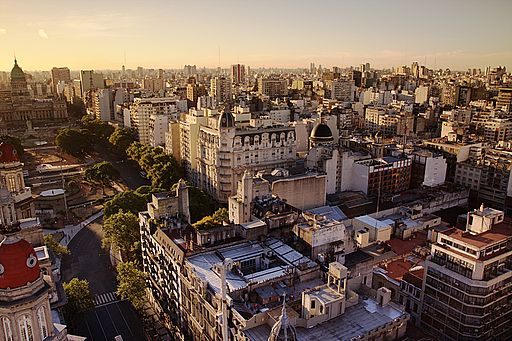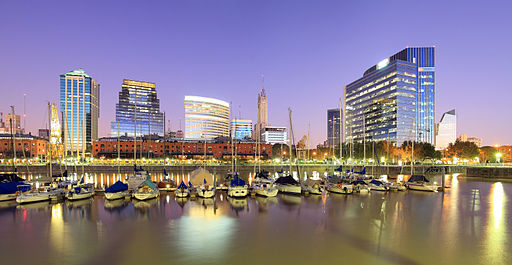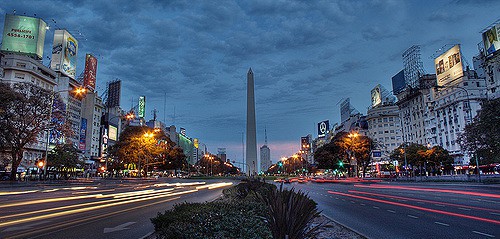5 Minute Guide to Buenos Aires
The Paris of South America: Buenos Aires. A little bit European, a little bit Latin American, and a whole lot of beautiful: it’s a city that stands apart. The capital of Argentina and home to Porteños with unique blend of Italian and Spanish (among other European nationalities) ancestry, Buenos Aires has something to offer any visitor. Although not as sprawling as the behemoth cities of São Paulo, Bogotá, or Lima, Buenos Aires is the second most populated city in South America. That means there is a lot of people with even more things to do and see! With this quick guide to exploring the city, you will be drinking mate (pronounced mah-tay) tea and dancing tango like a local in no time.

Photo of Congress via Wikipedia / Luis Argerich
Top Sites
The city is full of stunning European architecture, wide bustling avenues, unstoppable nightlife, and a thriving art scene. There is something for everyone, so you will want to make sure you have a flexible plan of what are your most important activities. The Casa Rosada Presidential house and Plaza de Mayo are the city’s center points of history. Teatro Colón is the country’s golden trophy, a shining Opera house and theater with world renowned acoustics. After its lengthy renovation, the beautiful theater is now open for performances such as ballet, opera, orchestra, and plays, often times at low cost or free. Tours are also available, where visitors can see the grand ornamental style of the lobby and theater. The MALBA (Museo de Arte Latinoamericano de Buenos Aires) is the city’s mecca of modern Latin American artwork. From Frida Kahlo to Diego Rivera, works from the entire continent are held here. The San Telmo Street Market is one of the most popular street markets in the city with a wide range of unique antiques, handmade artesanal goods and tango dancers in the street! Puerto Madero is the city’s newest neighborhood built in the last 20 years. With beautiful bridges linking it to downtown Buenos Aires, it was built on a ecological reserve made from discarded waste. La Boca was the first landing spot of European immigrants coming to Buenos Aires for a better life. It has now become a colorful neighborhood showcasing the early life of those immigrants, from brightly painted buildings, to tango dancing, and fútbol fanatics.

Photo of Buenos Aires via WIkipedia / Luis Argerich
Transportation
Public transportation is one of the city’s best assets. Easily get where you need to go by subway or bus, by spending a fraction of other major cities’ public transport prices. Of course, with the city’s distinctly flat terrain, walking around Buenos Aires offers a way to see the intricate architecture and city daily life. For nighttime outings or further destinations, take one of the abundant taxis driving the streets that won’t break your wallet.

Photo via flickr / Jesus Alexander Reyes
Weather
In general, the climate in Buenos Aires is mild all year round, without extreme spikes at any time in the year. Temperatures rise quickly in Buenos Aires summer months (December – February, average highs of 28C/83F, average lows of 17C/63F), so be prepared to sweat! Humidity percentages rise quickly and the sun shines bright and strong.
In Autumn (March- May, average highs of 22C/72F, average lows of 14C/57F) temperatures begin to cool down and the rainy seasons start, so make sure you are prepared for a range of temperatures. Some days are warm, some are cold and stormy.
Although it generally does not snow in Buenos Aires city, temperatures do drop in winter (June-August, average highs of 15C/59F, average lows of 7C/47F).
Since there is so much humidity in the air, the air and winds feel a lot colder than the temperature says. Spring (September- November, average highs of 22C/72F, average lows of 14C/57F) is finally here and it is time to rejoice in warmer weather and sunshine!
Learning Spanish? Check out our free Spanish level test and see how your successful your studies are!
Language
Planning a trip to Buenos Aires and realized you don’t speak a word of Spanish? Not to worry, as you can jump start your skills with a Spanish language course before you take to the streets to practice your “Rioplatense” Spanish. Porteños love to talk, whether it be with their best friend, cab driver, or doorman, there is never a shortage of conversation in Buenos Aires! The Spanish spoken in Buenos Aires is unique to any other spoken in the world. With a pronounced accent, fast dialogue, and a love for local slang, visitors may find it hard to initially catch onto spoken conversation in the capital.
The most notable difference to other spoken Spanish in Latin America is the pronunciation of “ll” or y” which actually sounds like “sh”. Imagine calle (street) pronounced as cashee. Notorious for speaking very fast and blending words together, Porteños are actually very welcoming to non native speakers practicing Spanish if you ask them to speak slower. Take note of vos which replaces tú (you) and comes with its own conjugation of verbs.
While this isn’t a complete guide, nor even half, this should get you started and pique your interest for heading down South and seeing what this global city has to offer you. Who knows, it’s magical streets just might engulf you yet!
